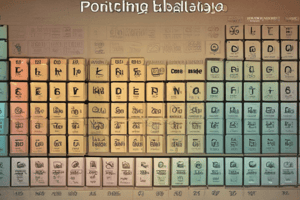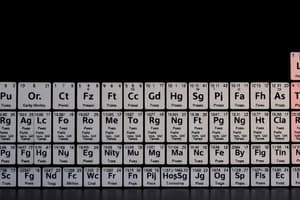Podcast
Questions and Answers
What is the term for the amount of energy required to remove an electron from a gaseous atom?
What is the term for the amount of energy required to remove an electron from a gaseous atom?
- Electronegativity
- Atomic mass
- Ionization energy (correct)
- Atomic radius
What is the charge of an ion that has gained one or more electrons?
What is the charge of an ion that has gained one or more electrons?
- Radical ion
- Cation
- Anion (correct)
- Neutral ion
Which direction does the first ionization energy trend increase in the periodic table?
Which direction does the first ionization energy trend increase in the periodic table?
- Right and down
- Left and down
- Left and up
- Right and up (correct)
After removing the first electron from an atom, how does the energy required to remove the second electron compare?
After removing the first electron from an atom, how does the energy required to remove the second electron compare?
Which of the following pairs exhibits the correct comparison regarding electronegativity?
Which of the following pairs exhibits the correct comparison regarding electronegativity?
What was the basis of Mendeleev's periodic table?
What was the basis of Mendeleev's periodic table?
Which group on the periodic table contains the most reactive elements?
Which group on the periodic table contains the most reactive elements?
Which of the following correctly defines a period on the periodic table?
Which of the following correctly defines a period on the periodic table?
Which of the following statements is true about electronegativity?
Which of the following statements is true about electronegativity?
What characteristic describes metals on the periodic table?
What characteristic describes metals on the periodic table?
What defines a group on the periodic table?
What defines a group on the periodic table?
How is the atomic radius defined?
How is the atomic radius defined?
What is the electron configuration for Sodium (Na)?
What is the electron configuration for Sodium (Na)?
Flashcards are hidden until you start studying
Study Notes
Periodic Trends
- Dmitri Mendeleev organized the periodic table by increasing atomic mass.
- Henry Mosely organized the periodic table by increasing atomic number.
- Periodic Law: Elements arranged in order of increasing atomic number show a periodic recurrence of their properties.
- Groups (columns) on the periodic table represent families of elements with similar properties.
- Periods (rows) on the periodic table show elements with varying properties as you move across the row.
- Alkali Metals (Group 1) are the most reactive.
- Noble Gases (Group 18) are the least reactive.
- Metals are located on the left side of the periodic table.
- Metalloids are located along the staircase line.
- Nonmetals are located on the right side of the periodic table.
- Representative Elements are located in the s and p blocks.
- Sub-levels have specific shapes:
- s: Sphere
- p: Dumbbell
- d: Clover
- f: Double Clover
- Malleable means a substance can be hammered into shapes.
- Ductile means a substance can be drawn into wires.
- Brittle means a substance is hard but can break or shatter easily.
- Coulomb's Law:
- Charge directly affects the force of attraction: Greater charge, greater force.
- Distance inversely affects the force of attraction: Greater distance, weaker force.
- Electron Configuration describes the arrangement of electrons in an atom's sublevels.
- Nitrogen (N): 1s2 2s2 2p3
- Sodium (Na): 1s2 2s2 2p6 3s1
- Cobalt (Co): 1s2 2s2 2p6 3s2 3p6 4s2 3d7
- Sulfur (S): 1s2 2s2 2p6 3s2 3p4
- Atomic Radius is half the distance between the nuclei of two identical atoms.
- Electronegativity measures an element’s tendency to attract electrons when chemically bonded.
- Ionization Energy is the energy needed to remove an electron from a gaseous atom.
- Removing a Second Electron: Requires more energy than removing the first.
- Cations are positively charged ions.
- Anions are negatively charged ions.
Periodic Trends in the Periodic Table
- Atomic Radius: Increases down a group and decreases across a period (towards the right).
- Ionization Energy: Decreases down a group and increases across a period (towards the right).
- Electronegativity: Decreases down a group and increases across a period (towards the right).
Identifying Trends
- Larger Atomic Radius:
- Ca (Calcium) is larger than Mg (Magnesium)
- Si (Silicon) is larger than N (Nitrogen)
- Br (Bromine) is larger than Ga (Gallium)
- P (Phosphorus) is larger than Rb (Rubidium)
- Larger 1st Ionization Energy:
- S (Sulfur) is larger than O (Oxygen)
- F (Fluorine) is larger than K (Potassium)
- Cl (Chlorine) is larger than Al (Aluminum)
- Fe (Iron) is larger than Al (Aluminum)
- Larger Electronegativity:
- In (Indium) is larger than B (Boron)
- Ga (Gallium) is larger than P (Phosphorus)
- Li (Lithium) is larger than K (Potassium)
- Al (Aluminum) is larger than N (Nitrogen)
- Larger Atom/Ion:
- F-1 (Fluoride ion) is larger than F (Fluorine atom)
- Mg (Magnesium atom) is larger than Mg+2 (Magnesium ion)
- Cr+3 (Chromium(III) ion) is larger than Cr+2 (Chromium(II) ion)
- P-3 (Phosphide ion) is larger than P (Phosphorus atom)
Studying That Suits You
Use AI to generate personalized quizzes and flashcards to suit your learning preferences.




